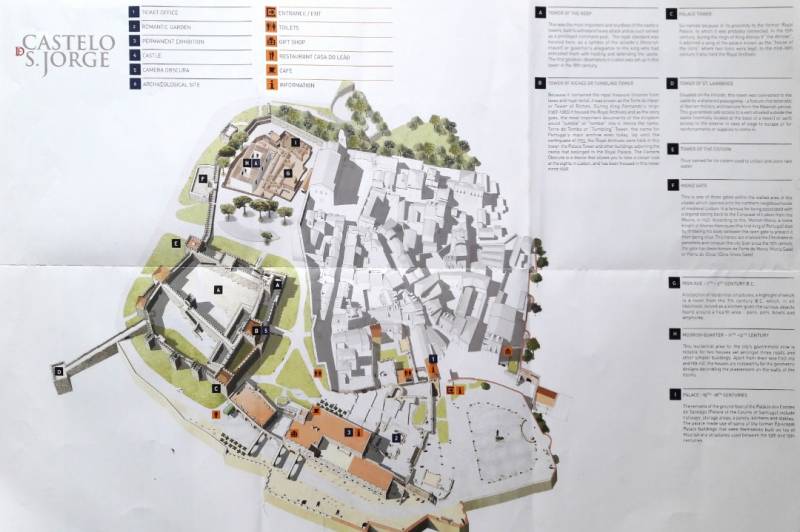Castelo de São Jorge


A - TOWER OF THE KEEP
This was the most important and sturdiest of the castle's towers, built to withstand heat attack and as such served as a privileged command post. The royal standard was hoisted here, as a symbol of the alcaide's [Moorish mayor] or governor's allegiance to the king who had entrusted them with holding and defending the castle. The first geodesic observatory in Lisbon was set up in this tower in the 18th century.
B - TOWER OF RICHES OR TUMBLING TOWER
Because it contained the royal treasure [income from taxes and royal rents), it was known as the Torre do Haver or Tower of Riches. During King Fernando's reign 11367-1383] it housed the Royal Archives and as the story goes, the most important documents of the kingdom would "tumble" or "to mbar" into it. Hence the name, Torre do Tombo or "Tumbling" Tower, the name for Portugal's main archive even today. Up until the earthquake of 1755, the Royal Archives were held in this tower, the Palace Tower and other buildings adjoining the castle that belonged to the Royal Palace. The Camera Obscura is a device that allows you to take a closer look at the sights in Lisbon, and has been housed in this tower since 1998.
C - PALACE TOWER
So-named because of its proximity to the former Royal Palace, to which it was probably connected. In the 15th century, during the reign of King Alonso V "the African . it adjoined a wing of the palace known as the "house of the lions" where two lions were kept. In the mid-16th century it also held the Royal Archives.
D - TOWER OF ST. LAWRENCE
Situated on the hillside, this tower was connected to the castle by a sheltered passageway - a feature characteristic of Iberian military architecture from the Moorish period. This guaranteed safe access to a well situated outside the castle [normally located at the base of a tower] or swift access to the exterior in case of siege to escape or for reinforcements or supplies to come in.
E - TOWER OFTHE CISTERN
Thus named for its cistern used to collect and store rain water.
F - MONIZ GATE
This is one of three gates within the walled area of the citadel which opened onto the northern neighbourhoods of medieval Lisbon. It is famous for being associated with a legend dating back to the Conquest of Lisbon from the Moors, in 1147. According to this, Martini Moniz, a noble knight of Afonso Henriques [the first king of Portugal] died by throwing his body between the open gate to prevent it from being shut. This heroic act enabled the Christians to penetrate and conquer the city. Ever since the 13th century, the gate has been known as Porta de Moniz [Moniz Gate] or Porta do rival [Olive Grove Gate).
G - IRON AGE - 7TH - 3RD CENTURY B.C.
A collection of residential structures, a highlight of which is a room from the 7th century B.C. which, IN all likelihood, served as a kitchen given the various objects found around a hearth area - pans, pots, bowls and amphorae.
H - MOORISH QUARTER - 11TH - 12TH CENTURY
This residential area for the city's government elite is notable for two houses set amongst three roads and other simpler buildings. Apart from their size [160 m2 and 190 m2], the houses are noteworthy for the geometric designs decorating the plasterwork on the walls of the rooms.
I - PALACE - 15TH - 18TH CENTURIES
The remains of the ground floor of the Palacio dos Condes de Santiago [Palace of the Counts of Santiago] include hallways, storage areas, a pantry, kitchens and stables. The palace made use of some of the former Episcopal Palace buildings that were themselves built on top of Moorish era structures used between the 13th and 15th centuries.
The Castelo de S. Jorge - National Monument occupies the most privileged area of the old medieval alcáçova [citadel] and consists of the castle, the ruins of the former royal palace as well as part of a residential neighbourhood which was home to the elite.
The fortification, built by the Moors in the mid-11th century, was the last defensive stronghold of the elite who resided within the citadel; the Moorish governor [whose palace was nearby] and the elite city administrators whose homes are visible today in the Archaeological Site.
After Dom Afonso Henriques conquered Lisbon on October 25th, 1147, to become the first king of Portugal, the Caste lo de S. Jorge began its golden age as a home for the royalty. The old Moorish-period buildings were modified and enlarged to accommodate the king, his court and the bishop, as well as the Royal Archives housed in one of the castle towers. Once the Portuguese kings had transformed the Castelo de S. Jorge into a royal palace in the 13th century, it was chosen to receive many notable Portuguese and foreign figures, as well as hold festivities and coronations during the 14th, 15th and 16th centuries.
When Portugal became part of the Spanish Crown in 1580, the Caste to de S. Jorge took on a more important military role which continued until the early 20th century. Some areas were converted, while new ones appeared. However, it was largely after the Lisbon earthquake of 1755 that the most substantial renovation work took place on the old medieval alcáçova, with many new buildings gradually covering over the older ruins. In the 19th century, military barracks covered the entire area of the present-day National Monument.
The castle and ruins of the former royal palace were rediscovered following major restoration work carried out between 1938 and 1940. Ancient buildings were rescued from amidst the ruins of previous demolition projects. The castle regained its former magnificence and was opened to the public.
Archaeological research conducted into several areas in the late 20th century was vital in ascertaining the antiquity of the hilltop settlement, as well as confirming the location's invaluable historical importance, justifying the Royal Decree of 1910 which declared the Caste lo de S. Jorge a National Monument.
Visitors can learn more about these past lifestyles from the evidence on display at both the Permanent Exhibition and the Archaeological Site now open for visits.
4 Castle
Built in the mid-11th century, during the Moorish period, this fortification is situated on the most inaccessible area at the top of the hilt, taking advantage of the natural slopes to the north and west. The purpose of the castle was to house military troops and, in the case of a siege, the elite who lived in the alc8cova [citadel]. Unlike most European castles it was not intended to perform a residential role. Eleven towers still remain, the most outstanding being the Torre de Menagem [Tower of the Keepl, Torre do Haver ou do Tombo [Tower of Riches or Tumbling Tower], Torre do Paco [Tower of the Palacel, Torre da Cisterna [Tower of the Cistern] and the Torre de Sao Lourenco [Tower of St. Lawrence] which is located on the hillside. Ruins of older structures and a cistern still remain in the second courtyard. Also found here is a small door on the northern wall called the Door of Treason which allowed secret messengers to enter or exit when needed. Three sets of steps leading up the sides of the walls provide access to the towers and the ramparts, one in the first courtyard and two In the second.
Ruins of the Citadel's Former Royal Palace
This collection of buildings, now housing the Permanent Exhibition, café and Casa do Leão Restaurant, provide the mast significant evidence of the former medieval royal residence. The Romantic Garden [2] and patios also display some architectural features that were part of the royal residence. The royal palace suffered heavy damage during the earthquake of 1755. Located at the entrance to the Permanent Exhibition, a century drawing is the best indication of what the Royal Palace and Lisbon were like before the earthquake.
Archaeological Site
These archaeological remains present evidence of the three most significant periods in Lisbon's history; ii] the first known settlements dating back to the 7th century B.C.; [2] the remnants of the Moorish-era residential area, from the time of the castle's construction in the mid-11th century; [3] the ruins of the last palatial residence of the old citadel destroyed by the earthquake of 1755.
Permanent Exhibition
Open to visitors, this collection consists of objects found in the Archaeological Site and provides an introduction to the various cultures and lifestyles [from the 7th century B.C. to the 18th century), which contributed to the building of the Lisbon we know today, with particular emphasis on the Moorish period from the 11nth to 12th centuries.
Camera obscura
This camera obscura, an optical system of lenses and mirrors, provides 3600 detailed views of the city in real time, including its monuments, most emblematic areas, the river and the bustle of Lisbon itself.
Viewpoint
Due to its exceptional location, Caste to de S. Jorge stands out among Lisbon S viewpoints for its unique and majestic sights.



















